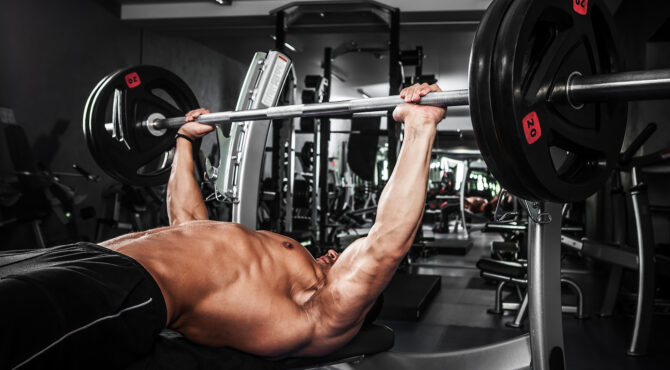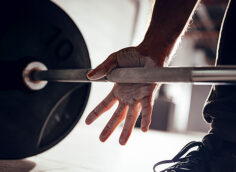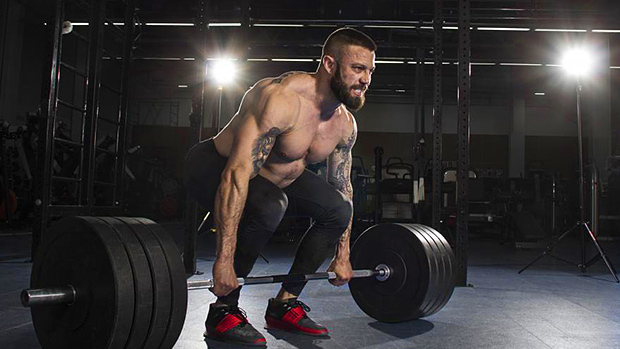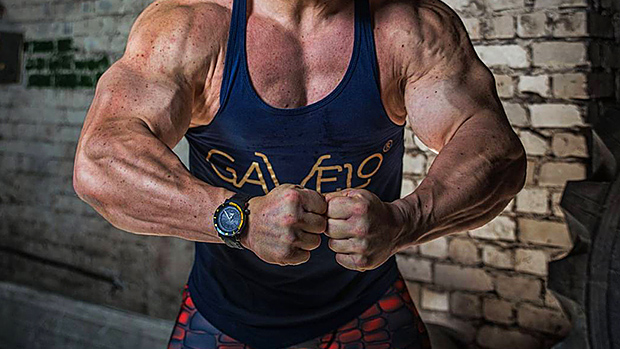You know about proper lifting form. But do you know how to set yourself up for a heavy lift without a spotter? And do you know how to bail when things go sideways? Let's get into it.
Bench pressers get a liftoff from a spotter to achieve the right starting position and have the shoulder blades placed in an ideal spot on the bench. It sets the tone for the whole set and can be a limiting factor in performance if it's not done right.
But good spotters are hard to find, especially if you lift in your basement or garage. A proper self-liftoff requires more than just pressing the weight out of the rack.
Depending on the height of the hooks/holsters relative to your arm length, there's a good chance you'll be compromising your shoulder position when you press the weight out of the rack.
You can help your cause by the way you set up your rack, but it takes a little more finesse to start things out right – especially since it's damn near impossible to reset once the load is over your chest.
Raise the hips off the bench to put your body on a decline while you unrack. The friction and pressure you place on your shoulder blades will reduce some of their mobility and stabilize the arms and shoulder capsule to get you started in a better position.
Lower your hips into position once the bar is over your chest and in place for your first eccentric/lowering rep.
What Happens When You Get Pinned Under the Bar?
Ideally, you always have a spotter when attempting rep-range maxes, but hey, it happens.
First, other things can cause you to get pinned that have nothing to do with over-estimated your max, like an injury. Be prepared for anything. The simple answer? Don't put clips on the bar.
Assuming you're not in a cage or some apparatus that has adjustable safety pins, you can tip the bar to one side to let the weights slide off, setting you free and saving your neck. You might crack a few floor tiles, but it's a worthy tradeoff.
I often see people sitting upright between sets, nervously eyeing the heavy dumbbells on the floor. They often haphazardly swing the dumbbells up to the starting position if they don't have a spotter, which almost guarantees a poor setup.
What Happens When You Need to Bail?
Once you reach failure, scan the room to ensure there are no service-Chihuahuas in the area, and then let the weights crash to the floor (while maintaining a strong grip on them for some control). Don't be a douche who lets the weights flip and tumble all the way across the gym. Completely unnecessary. And you know it.
Squatting in a cage compels you to set the pins in the perfect place to catch the bar in the event of a missed rep.
As a rule, set the pins up to no more than 6 inches below your bottom squat depth. If you're a half squatter, adjust accordingly. If you're squatting deep, do the same.
What Happens When You Need to Dump the Weight?
It's a little less feasible to try tipping an unclipped squat bar to let the weights slide off. It's more feasible to rely on those safety pins and allow the bar to crash down into them. In doing so, you have a decision to make between bailing forward or bailing backward.
For back squats, I'd recommend bailing forward. You'll have more control over the bar since you don't have to compromise your grip or hand position. Bailing backward is possible too, but there's a chance the bar pinches your mid-back (remember, your torso will be on a forward lean) or overextends your wrists since your fingers can't get out of the way fast enough. Plus, bailing backward will also result in an awkward "hop" forward. There's limited room for that in a typical squat cage.
Remember, It's Embarrassing to Be Found Dead Underneath a Weight
In the heat of the moment, it's unlikely you'll have the time to think your way through these scenarios as pragmatically as it's being laid out here, but focused sets and overall preparation can help to ingrain the right reaction to a situation where needed.
Proper spotting is a lost art. Scratch that. Proper spotting is a non-existent art. Time to change that.
If you're really doing your job as a spotter, then your mentality should be to apply assistance to the lifter only when needed. Your presence as a spotter should create confidence in the lifter to assure him that he's got help if the bar stops moving. If the bar doesn't stop moving, you shouldn't help it.
That doesn't mean it's your job to be negligent. A spotter should be engaged and "close by" on each rep in case something happens. They're also there for motivation and verbal cueing, which can go a long way.
A quick rundown of how to spot the basic movements:
Spotting the Barbell Bench Press
You've gotta get up close and personal. That may mean stepping in so you're hovering right over the lifter, private parts intimately close to the lifter's head. (That's what they signed up for in enlisting a spotter, and if safety's the name of the game, it is what it is.)
The hands should be on or near the bar in a double-overhand or, at the very least, a mixed grip. The reason? It's more realistic to ROW a heavy bar off of someone's chest than it is to CURL it off (with an underhand grip).
Spotting the Squat
The smartest way to spot a squat is by landmarking the lifter's obliques: lay your hands lightly on the sides of the lifter's waist. This creates instant feedback and allows the lifter to stabilize the spine and keep the torso erect. It's also a reliable way to help a lifter get out of the hole when reaching a sticking point.
It's much more efficient than spotting at the bar and more appropriate (and safe) than spotting around the chest.
Spotting the Dumbbell Press
Spot the lifter at the wrists, not at the elbows. I don't care what your bros do. The latter is a method that's full of risk. Think about it: Spotting heavy dumbbells at the elbows may help with force production, but it leaves the forearms completely hanging out to dry.
That means one moment of instability or one non-linear push of assistance can lever the dumbbells flying right into a lifter's face. And there are plenty of YouTube fail videos to show that it happens.
The average person can provide 15 to 20 pounds of assistance from a grip around the wrists, so if a lifter needs more than a spot at the wrists for his dumbbell bench or shoulder presses, he's lifting a weight that's too heavy. Period.





